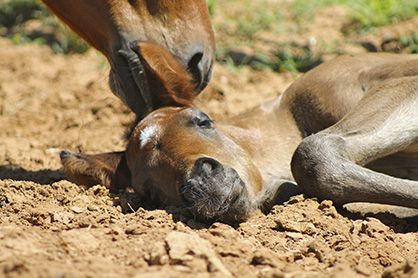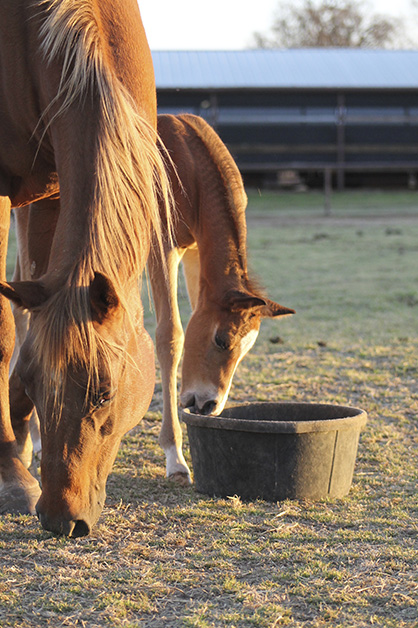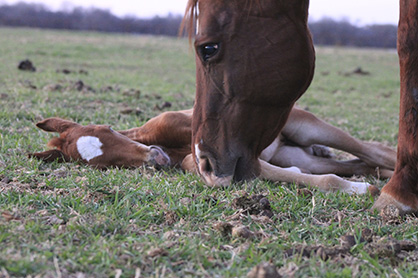Responsible and Purposeful Breeding in the Horse Industry
By: Jackie Bellamy-Zions for Equine Guelph
The words responsible and breeding should be an inseparable pairing in the horse industry. The successful future of a foal depends heavily on the investment of the breeder to:
1) financially project costs from conception to sale or lifespan of the horse if it is to be kept.
2) research, research, research! The homework list is a long one including choosing a mare and stallion with great conformation and temperament, investigating their performance records, checking fertility rates, health records, offspring records and more…
3) educate themselves and plan ahead. Impeccable stable management and genetics knowledge combined with understanding special nutrition and healthcare requirements for the broodmare, foal and breeding stallion are all prerequisites to breeding horses responsibly.
In the following article, two experienced and successful horse breeders: Dr. Moira Gunn of Paradox Farm and Doug Nash, formerly from Glengate, have taken the time to share some of their vast knowledge. Dr. Gunn has had recent cause for celebration when Lexi Lou, bred by Paradox farm, received the 2014 Canadian Horse of the Year award after a string of wins including the Queen’s Plate and the Oaks. Nash was farm manager at Glengate (formerly Cantario Farms) for almost 30 years. Glengate consisted of three farms, housing 80 – 100 mares, eight stallions, and yearlings. In addition to servicing 1,200 mares annually with their own stallions, Glengate collected, shipped, froze, evaluated, imported and exported semen for 125 to 140 stallions of all breeds and disciplines. Nash has also shared his knowledge as an instructor for Equine Guelph’s online Growth and Development course.
Both breeders were candid discussing one of the most important considerations − ensuring financial means to see the horse through to a purposeful life. From stud fees to reproductive health exams and specialized nutrition, there is much to consider in calculating the bottom line. Stud fees can range anywhere from $200 – $200,000! When discussing logistics, Nash gives an example, “If you are breeding for profit, you would not spend over $3,000 in stud fees, if your broodmare is worth $10,000.” Nash also expects private operations will not incur less than $14,000 (excluding the stud fee) in costs leading up to a yearling sale. In commercial operations this number would be closer to 17 or $18,000. Gunn explains daily costs of boarding just a broodmare vary widely and range up to $40/day.
“Quality of care” questions should include the size of stalls and pasture. Methods and frequency of ongoing nutritional analysis should be discussed, for example, testing each batch of hay, soil testing the fields, and consulting with a nutritionist to balance feed rations. Both Gunn and Nash concur that selecting the best genetics in the world will not help if paramount importance is not placed on the special nutritional needs of the broodmare and foal. An excellent in-depth understanding of nutrition, including protein requirements, micro-minerals, etc. is crucial to guard against the myriad of developmental conditions that could seriously affect the horse’s future potential. Gunn points out, “the number one mistake I see people make is not understanding the nutritional program required prior to conception, during pregnancy and in the first two years of life of a foal.”
Nash and Gunn understand the value of a reproductive exam, especially if it is suspected the mare may have troubles conceiving or has lost a foal in the past. Nash explains the reproductive exam is much the same as a pre-purchase exam, checking for good overall health but also including the reproductive tract. Gunn described elements of the exam such as performing an ultrasound to check size, shape and consistency of the uterus and inspecting the vulva conformation (i.e. too sloped could predispose windsucking). On a suspect mare, a uterine culture and biopsy can also provide important information. If the mare has a cresty neck, hormone profiles can check for hypothyroidism. Nash comments, “Money spent today on a reproductive health exam can save you tomorrow by avoiding an abortion.” Following the reproductive exam there will be many veterinary service calls including palpations and ultrasounds which can run approximately $1,000 – $2,000.
Once the budget hurdle has been cleared, the homework begins. One of the biggest questions to answer is WHY are you breeding? Knowing your expectations of the foal will help you make realistic selections when it comes to choosing an appropriate pairing considering size, breed, athletic ability, temperament… which brings us to WHO? When looking at performance records, it is important not to skip over the broodmare and look only at the stallion. Look for the traits, conformation, personality and athletic ability desired in both parents. An ideal body condition score (5-6 out of 9) and good overall health including up to date health records (vaccines, worming…) should exist for the dam and stud. Nash states he likes a mare who adapts quickly to new surroundings and possesses a pleasant attitude. Age is a special consideration for the mare as a decline in reproductive ability starts between the ages of 12 and 15. The older mare may have trouble bringing a pregnancy to term. Expanding on the importance of health Nash cautions, “Horses in pain do not conceive.” A mare retired from work is not an automatic breeding prospect, depending on the reason. For example a mare with chronic laminitis is not a breeding candidate.
Nash advises the selection process when deciding to breed horses involves three to four months of homework. He looks at performance records not only of the stallion but also the offspring. The size and conformation of the offspring should be noted. “Find out as much about the stallion as you can,” says Nash. This includes questions such as live foal rate? A thorough check for any hereditary conditions is a must. Breeding for your own preference needs to be carefully balanced by being cognizant of the marketplace to avoid unwanted horses and paddock ornaments.
After the WHY and WHO comes HOW? Live, fresh or frozen is the next topic to study. “Professional breeders will be able to provide semen analysis and be able to tell you how well it transports either fresh or frozen,” says Gunn. Raw motility and extended motility are important considerations when transporting semen. Morphology of semen and track records of fertility should also be available. If the mare in question has had difficulty conceiving, you are better off selecting a stallion with high fertility rates. If considering live cover, not all of this information will necessarily be available but past track records of getting mares into foal should be unless it is the stallion’s first year standing at stud. A semen evaluation will also give insight as to how many mares the stallion can breed in a day. When choosing live or fresh semen, you must also ensure timing of ovulation and sperm delivery are accurately synchronized. For a live cover, Nash recommends a site visit and inquiring about the facilities health, safety and biosecurity procedures. When using frozen semen, Gunn explains frequent palpations will be necessary for the mare throughout the day and night to have success with this method as timing is critical.
WHEN it comes to stable management, you need to be a planning pro with a dedication to details. On top of impeccable general standards, breeding facilities need to provide a suitable environment for broodmares and foals. The foaling area needs to provide ample room to avoid injury during birth. Stalls should have solid walls with dimensions of 16 x 12 being more desirable. In the turn out area, the addition of skylights in three sided sheds make use of sunlight to kill bacteria. Pasture fences should be constructed so the foal cannot roll out of the paddock when lying down. For example: post and board fencing with a fourth rail is often used to contain young stock. Hay racks need to be attached high enough up on the wall that a foal or yearling cannot get hung up. Creep feeders allow weanlings to feed undisturbed and reach their nutritional requirements. It is important to ensure the weanling is consuming enough feed prior to weaning to ensure there will not be a shock on its nutritional development.
At weaning time, it is ideal to move the pair out of visual and vocal contact to reduce the risk of injury should they try to reunite. Have a plan for companionship for the mare and weanling after they are separated. The weanling could be introduced to other weanlings or an older gelding. Equine Guelph has published new research on Two-stage weaning as another method of weaning. Last and certainly not least, it is important to plan every step of the way with your veterinarian to ensure good health before, during and after foaling. Vaccinations and boosters need to be given at the correct times and accurate records kept. They may also be able to direct you to a source of colostrum, should there be any issues in the crucial time after the birth. This information is worth checking into before you need it. Planning every detail ahead of time is required to prepare for any eventuality.
Responsible breeders perform due diligence in all areas of stable management, financial planning, and market research. The investment of hard work, homework, record keeping and proper care is realized when horses reach their full potential. If you are the owner of such a horse – it all began with the responsible breeder.
Other articles and resources you may be interested in:
Nutrition Right from the Start Vaccination Equi-Planner When to Vaccinate Broodmares video Colostrum from the Worms & Germs blog Two-Stage Weaning Dr. Tracey Chenier on Research Radio discussing preparation for breeding season
For more education in responsible breeding check out Equine Guelph’s online courses including: Equine Growth and Development and Genetics.
Nutrition Right from the Start: http://www.equineguelph.ca/news/index.php?content=438
Vaccination EquiPlanner: http://www.equineguelph.ca/Tools/equiplanner.php
When to Vaccinate Broodmares video: https://www.youtube.com/watch?v=YnL68L5smsE
Colostrum: http://www.wormsandgermsblog.com/files/2006/11/JSW-MA1-Colostrum.pdf
Two-stage Weaning article – page 3 of EG Newsletter http://www.equineguelph.ca/pdf/newsletter/EG%20newsletter%20Spring%202013_web.pdf
Research Radio (Dr. Chenier’s podcast on preparation for breeding season) http://www.equineguelph.ca/research/radio.php













